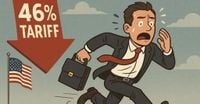On April 3, 2025, the United States announced a staggering 46% countervailing duty on goods imported from Vietnam, marking the second highest rate among 25 economies affected by this new tariff regime. This announcement came as part of a broader strategy by the Trump administration to address what it describes as a significant and ongoing trade deficit.
Starting April 5, 2025, all goods imported into the U.S. will be subject to a baseline 10% import tax. This rate applies universally, affecting all nations and their exports to the U.S. However, from April 9, 2025, larger trading partners will face even steeper countervailing duties, which are intended to counteract what the U.S. government sees as unfair trade practices.
Despite the high countervailing duty, not all Vietnamese products will be subject to this tariff. According to Mr. Do Ngoc Hung, Head of the Vietnam Trade Office in the U.S., certain categories of goods are exempt from the 46% duty. These include products covered by 50 USC 1702(b), which encompasses personal communications, gifts, and travel-related transactions. Additionally, steel and aluminum products, along with automobiles and auto parts that are already taxed under Section 232 of the Trade Expansion Act, will not incur the additional countervailing duty.
Some other exempted products include copper, pharmaceuticals, semiconductors, and various energy products. Notably, gold bullion and certain minerals not available in the U.S. will also be spared from the 46% tariff. This exemption is significant, as it highlights the U.S. government's intention to protect its domestic industries while still allowing for some level of trade with Vietnam.
In response to the tariff announcement, Prime Minister Pham Minh Chinh convened a meeting with various ministries to assess the situation and discuss potential solutions. Deputy Prime Minister Ho Duc Phoc is scheduled to visit the U.S. and Cuba from April 6 to April 14, 2025, to further address these trade issues. On the same day as the tariff announcement, Minister of Industry and Trade Nguyen Hong Dien proposed that the U.S. postpone the tariff decision to allow for further dialogue and negotiation.
The Ministry of Finance in Vietnam is currently reviewing all import and export items to understand the rationale behind the U.S. imposing such a high countervailing duty. According to the Ministry, Vietnam's average import tax is only 9.4%, significantly lower than the new countervailing duty. Most U.S. products exported to Vietnam are subject to a tax of 15% or less, indicating a disparity in the trade relationship.
Mr. Nguyen Quoc Tuyen from TVI Securities explained that the U.S. applies two different tax rates: a basic tax and a countervailing duty. The basic tax of 10% is applied to all imports, while the countervailing duty is calculated based on the trade deficit each country has with the U.S. The 46% rate for Vietnam represents the highest possible ceiling, which could be adjusted following negotiations.
Moreover, the Ministry of Finance has indicated that it is essential to clarify the misunderstanding surrounding the countervailing duty. Many investors mistakenly believe that Vietnam's high tax on U.S. goods has led to this retaliatory tariff. However, the U.S. tax method uses a formula that considers the trade deficit, which has resulted in the substantial countervailing duty for Vietnam.
In a broader context, the Vietnamese government has been proactive in reducing import taxes on various U.S. goods, including agricultural products. For instance, the import tax on frozen chicken legs has been reduced from 20% to 15%, while taxes on pistachios and almonds have also seen significant reductions. This effort reflects Vietnam's commitment to fostering a cooperative trade relationship with the U.S.
As the situation develops, it remains to be seen how the new tariffs will impact specific industries within Vietnam. Mr. Vu Duy Khanh from Smart Invest Securities noted that sectors most likely to suffer include electronics, textiles, leather footwear, and seafood. The new tariffs could also indirectly affect real estate in industrial parks, as attracting foreign investment may become more challenging.
Interestingly, while Vietnam's countervailing duty is high, it is still lower than that imposed on China, which will face a cumulative duty of 54% when considering existing tariffs. This comparison underscores the competitive challenges Vietnam faces in the global market.
On April 4, 2025, Foreign Ministry Spokesperson Pham Thu Hang expressed Vietnam's regret over the U.S. decision to impose countervailing duties. She emphasized that this decision does not reflect the spirit of the comprehensive strategic partnership between the two nations and could negatively impact bilateral economic relations.
The Vietnamese government is committed to continuing discussions with the U.S. to find practical solutions that benefit both countries. Following the announcement of the new tariffs, President Trump indicated his willingness to negotiate tariffs with other nations, suggesting a potential path forward for resolving trade tensions.
As negotiations unfold, the Vietnamese government will be closely monitoring the situation, seeking to mitigate the impact of the tariffs on its economy while advocating for a fair and equitable trade relationship with the United States.







